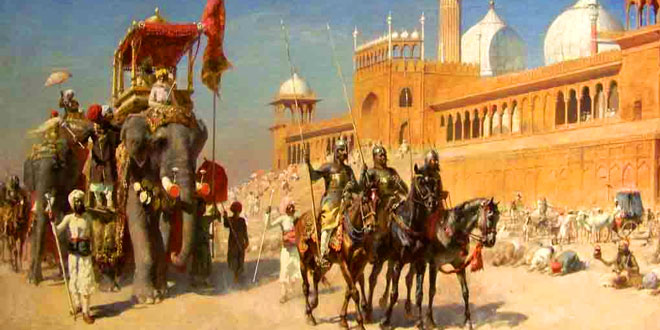New Kings and Kingdoms: NCERT 7th CBSE Social Studies Chapter 07
Question: Write a short note on the Paramaras.
New Kings and Kingdoms – Answer: The Paramaras dynasty of Rajputs ruled the region around Malwa from the 10th to the 12th centuries CE. The most famous ruler of this dynasty was Raja Bhoj, who ruled from 1010-1060 CE. The capital of the Paramaras was at Dhar. The Paramaras ruled till 1305 CE, when Malwa was conquered by Alauddin Khilji, The Khalji Sultan of Delhi.
Question: Write a paragraph on the Palas.
Answer: After the death of Harsha, in 750 CE, the people elected one Gopala as their ruler. His son, Dharamapala, founded the Pala Dynasty (775-810 CE). Under Dharampala and his son, Devapala, the Pala kingdom grew to include present day Bengal, Bihar and parts of Odisha. One of the later Pala kings, Mahipala was defeated by Chola king Rajendra Chola in 1203 CE. They were the last major Indian dynasty to embrace Buddhism. The University at Nalanda was revived by the patronage of the Palas. Dharampala established a famous Buddist monastery and college at Vikramashila.
Question: Who was Mahmud of Ghazni? What was the purpose of his invasion of India?
New Kings and Kingdoms – Answer: An Ambitious Turkish chief, Sabuktgin, the Amir of Ghazni took advantage of the fragmented state of kingdoms, and attracted by tales of the riches of India. One of his sons, Mahmud of Ghazni, attacked India several times between 1010 and 1026 CE, taking back with him vast riches from India.
Mahmud of Ghazni captured Kangra, Mathura, Kannauj, Thanesar, Gwalior and Somnath. He was interested in ruling the territories he conquered. His purpose to invade India was only to take away the vast riches.
Question: Write who were the participants and what was the result of the First Battle of Tarain and the second Battle of Tarain?
Answer: First Battle of Tarain: In 1191 CE, Prithviraj challenged and defeated Mohammad Ghori, the Turkish invader.
Second Battle of Tarain: In 1192 CE, Mohammad Ghori defeated Prithviraj Chauhan.
Question: Who were the Rajputs? Why is the period between 8th and 12th centuries CE known as the Rajput period of Indian history?
Answer: The Rajputs were clans, or social groups based around present day Rajasthan. They claimed descent from the Kshatriyas. The Rajputs were staunch Hindus. They created large empires and resisted the advance of the Arabs and Turks. They protected their land and religion with fierce patriotism. Their contribution to the politics and culture of India between the 8th and 12th Centuries CE was so immense that this period of Indian history came to be called Rajput Period.
Question: Who were the Partiharas? Describe how and where they came to power and how their kingdom ended.
Answer: Many historians claim that Gujaras came ti India with the Huns a warlike tribe from Central Asia at the end of the 5th century CE. They established their kingdoms in Punjab and Southern Rajasthan. By the time Hieun Tsang visited India in 7th century CE, they had come to be considered kshatriyas and of Indian origin. The Pratiharas were one of the most powerful of the various Gujara clans and the empire they established came to be known as Gujara-Pratiharas.
Nagabhata I (730-756 CE) established the Pratihara dynasty and took control of Ujjain. He was known for his repeated resistance to Arab invasion. After almost a century Nagabatta II captured Kannauj, the imperial city of Harsha, and made it his capital. His grandson Bhoja I (836-886 CE) was a powerful ruler. Under him the territory of Guajara-Pratiharas stretched from the foothills of Himalayas to the River Narmada and from Bengal to Sind.
The Gujara-Pratihara Empire broke up into several independent kingdoms around 950 CE. Around 1019 CE, Mahmud of Ghazni took control of Kannauj. This spelt the end of the Pratihara dynasty.
 Class Notes NCERT Solutions for CBSE Students
Class Notes NCERT Solutions for CBSE Students




Please answer the question: A Chola period inscription, carved out of stone, declares that destroyers of the tank will go to the deepest of hell and one who maintains it well will be rewarded with great riches and luxuries in his next birth’. What possible conclusion can you draw from the above statement?
Who helped to perform the ritual Named Hiranya garbha
Are they farmers ‚ bramnas Traders
ITS ALL ABOUT THEIR CULTURE WHICH IS FURTHER DIVIDED AND KNOWN AS SAMANTS
What is meant by tribhuvana chakravartin
Lord of the three worlds.
Who introduced a silver coin called rupiah?